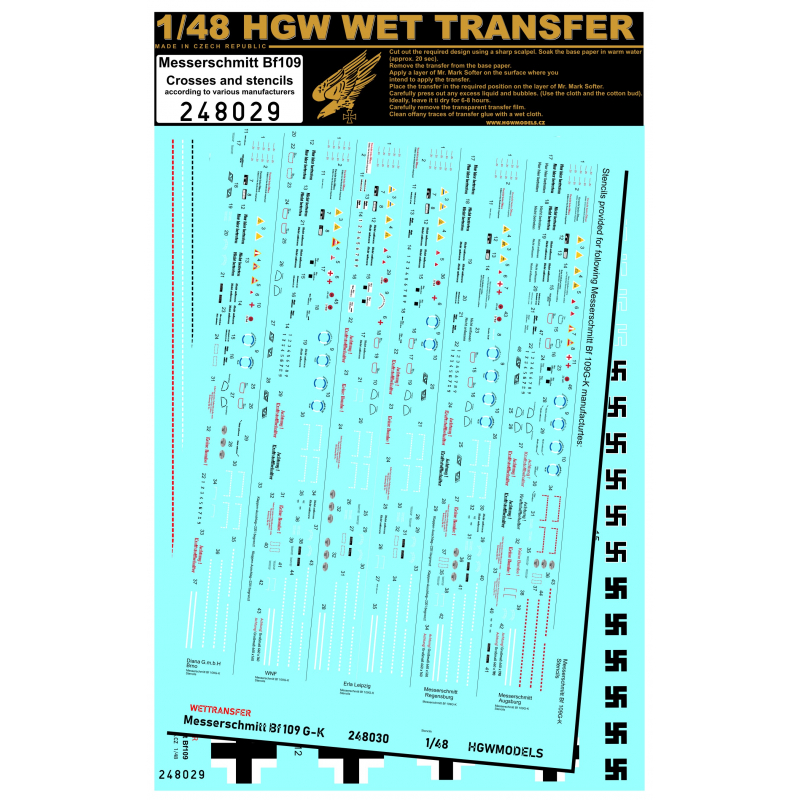Hračky
Celkem 218 produktů
1/48 Messerschmitt Bf109 Crosses + Stencils - Wet Transfers - various manufacturers. Crosses and stencils for Messerschmitt Bf109 in 1/48 scale. Wet transfer technology means that decal doesn't leave any signs of varnish or typical film after its application, so only text or symbols stay attached to the surface. The biggest issue relating to using ordinary decals is the varnish which creates a glossy film around the decal. It is quite hard to work with classic decals the way to make this film invisible and it is impossible to reach a good result in case of metallic surfaces. OK, there are dry transfers on the market but work with them is also quite uncomfortable, it is hard to place them correctly and a modeler has the one chance only. HGW's wet transfers are similar to ordinary decals. It is possible to move them during the attaching process and find the best position. Then just push the water from below the transfer, let it dry few hours, remove the transfer foil and work is done. Only text or symbol stays attached to the surface. Instructions: 1. Cut the required part.2. Soak in hot water and wait till the decal loose its base-paper.3. Apply as regular decal.4. Push the water from below the decal.5. Let it dry for 2-3 hours.6. Remove the transfer foil and clean the glue stains with water.
1/48 Messerschmitt Bf109 Crosses + Stencils - Wet Transfers - various manufacturers. Crosses and stencils for Messerschmitt Bf109 in 1/48 scale. Wet transfer technology means that decal doesn't leave any signs of varnish or typical film after its application, so only text or symbols stay attached to the surface. The biggest issue relating to using ordinary decals is the varnish which creates a glossy film around the decal. It is quite hard to work with classic decals the way to make this film invisible and it is impossible to reach a good result in case of metallic surfaces. OK, there are dry transfers on the market but work with them is also quite uncomfortable, it is hard to place them correctly and a modeler has the one chance only. HGW's wet transfers are similar to ordinary decals. It is possible to move them during the attaching process and find the best position. Then just push the water from below the transfer, let it dry few hours, remove the transfer foil and work is done. Only text or symbol stays attached to the surface. Instructions: 1. Cut the required part.2. Soak in hot water and wait till the decal loose its base-paper.3. Apply as regular decal.4. Push the water from below the decal.5. Let it dry for 2-3 hours.6. Remove the transfer foil and clean the glue stains with water.
1/48 Kampfstift. Stavebnice německého druhoválečného bombardéru Dornier Do 17Z. První prototyp Do-17C byl zalétán 23. listopadu 1934. Brzy prototyp dostal typové označení Do-17 V1. V květnu a září 1935 se uskutečnily první lety dalších dvou prototypů Do-17 V2/V3. Luftfahrtkommissariat projevoval o novou konstrukci od samého počátku velký zájem. První prototyp Do-17 V1 byl postaven výhradně pro vojenské letectvo, zatímco další dva prototypy byly vyvinuty jako osobní letouny. Vojenská verze letounu měla dvě trupové pumovnice umístěné na pravé straně jeho střední části, z nichž každá mohla pojmout pět svisle zavěšených 50kg pum. Posádku Do-17 V1 tvořily tři osoby: pilot zaujímající sedadlo na levé straně kabiny, navigátor-bombometčík za ním a střelec-radiotelegrafista. V obou bočních stěnách trupu byla čtyři malá okénka zajišťující střelci lepší výhled. Již počátkem roku 1936 se připravovala sériová výroba verzí Do-17E-1 a F-1. V roce 1936 se začalo s výrobou letounu. Brzy byla zahájena výroba obou verzí. Letouny Do-17F-1 byly zbaveny pumových zaměřovačů a vystřelovačů, ale byly vybaveny přídavnou palivovou nádrží a třemi fotografickými kamerami s pevným pásmem. V roce 1937 se začaly vyrábět verze Do-17E-2 a E-3, následované Do-17F-2, které se od svých předchůdců mírně lišily vybavením. Celkem bylo vyrobeno 536 letounů Do-17 E a F, z toho 268 v domovském závodě a zbytek v licenci v jiných závodech. Od počátku roku 1937 stroje používaly jednotky Luftwaffe. Nejrozšířenější verzí byl model Do-17Z, který byl vyroben v počtu 872 exemplářů. Letoun se velmi dobře osvědčil během španělské občanské války a španělského tažení. Účastnil se také bojů proti Francii a bitvy o Británii v roce 1940. Tam utrpěl poměrně vysoké ztráty, což znamenalo, že po roce 1940 byl v liniových jednotkách postupně nahrazen bombardéry Ju-88 a He-111. Stažené Do-17 byly používány především jako vlečné kluzáky. Technické údaje (verze Do-17Z): Maximální rychlost: 410 km/h, maximální strop: 8200 m, operační rádius: 1010 km, výzbroj: pevná-6 kulometů MG15 ráže 7,92mm podvěšených-do 1000kg pum. Nesestavený a nenabarvený plastikový model. Ke kompletaci stavebnice je třeba dokoupit barvy, lepidlo na plastikové modely, ředidlo, štětce, které nejsou součástí balení.

